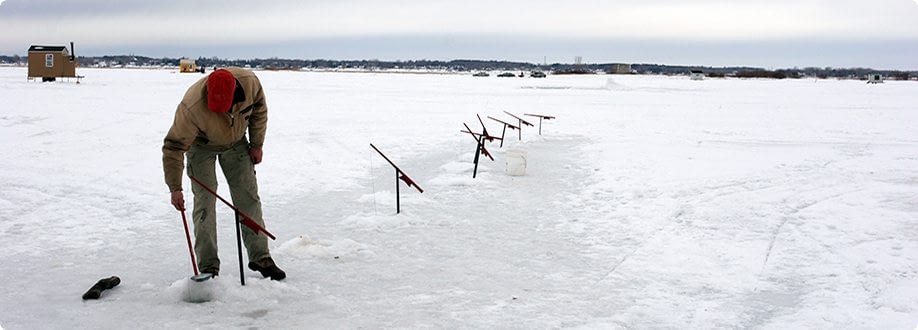

“People were ice fishing about 20-30 yards from shore by the outlet at Clear Lake. I was probably 10 yards from shore. You could see footprints where people walked to get out there. There was a crack in the ice and people were stepping over that.”
Hintz, now a senior claims adjuster at Grinnell Mutual, stopped to look at the crack, which broke immediately.
“I went in the water,” said Hintz. Thanks to the buoyant snowmobile suit he wore that day, he bobbed back up. “I pushed myself out and went home.”
Proper ice fishing gear can save lives
People who enjoy ice fishing need more than just a rod, reel, bait, and tackle box. Because no ice is completely safe, the Minnesota Department of Natural Resources recommends that ice fishermen should also bring gear— ice picks, personal floatation devices, nylon rope, and wool blankets—to help themselves or a fellow fisherman get out of the water.
“If you go through you’ve got to be able to get out to avoid hypothermia or drowning,” said Hintz. “I wear a tool around my neck with two prongs on it that I can jab into the ice to pull myself up out of the water back onto the ice if I should happen to go through. Hopefully that never happens again since I am a lot more cautious and will not venture out on thin or questionable ice.”
“There are self-inflating life jackets on the market,” said Grinnell Mutual Claims Adjuster Paul Christensen, also an avid ice fisherman. “You want to have something to grab onto and that will inflate if you go through the ice.”
“Never go out on the ice alone,” added Hintz. “Always make sure you tell someone exactly where you are going.”
Know where you’re going
“Don’t pick a lake and start walking on the ice. That’s a big mistake,” said Christensen. “Go with someone who has gone before and is familiar with the lake.”
Each lake, pond, and river behaves differently in winter months and some bodies of water are never safe for ice fishing. A variety of factors affect ice thickness, including air and water temperatures, snow cover, water currents, and even the fish themselves. The Minnesota Department of Natural Resources cautions ice fishermen that ice can vary from two inches to two feet in thickness in just a matter of feet.
“River ice is unpredictable,” said Hintz. “It has a current going through that can eat away at the ice from underneath, especially if the water coming in is a little warmer. The flow of the water doesn’t allow the ice to form as thick as pond or lake ice.”
“A farm pond will cool down and warm up faster than a larger lake,” said Christensen. “With a farm pond, you can go out one week and have six inches of ice and go out a week later and have only two inches.”
Inspect the ice
 “I don’t want to risk my life going out on ice,” said Hintz. “A few weeks ago the pond where I live had frozen over with good, clear, solid ice. I could walk out in the shallow areas along the edge and see through the 4-inch-thick ice all the way to the bottom on my pond. That was good, safe ice.”
“I don’t want to risk my life going out on ice,” said Hintz. “A few weeks ago the pond where I live had frozen over with good, clear, solid ice. I could walk out in the shallow areas along the edge and see through the 4-inch-thick ice all the way to the bottom on my pond. That was good, safe ice.”
Ice should be a minimum of 4 inches thick for ice fishing. Ice that is slushy, whitish, or otherwise discolored will not be as strong as clear ice. Snowmobiles and ATVs require at least 5 inches of clear, solid ice. Cars and light trucks need at least eight inches.
The Minnesota Department of Natural Resources recommends checking the ice every 50 yards by using an ice chisel or ice auger to create a hole to check ice thickness. Hintz prefers a gas-powered ice auger while Christensen uses a hand auger.
“I’ll walk out from shore a little ways where it’s deep enough to drill a hole and then take a tape measurer to measure from the bottom lip of the ice to the top,” said Hintz. “I have a spoon to scoop ice from the hole that is marked with inches so I can measure with that, too.”
Have fun
The danger of falling through ice into frigid water doesn’t keep Hintz or Christensen from their favorite winter pastime. For many Midwesterners, ice fishing is a fun and relaxing sport when approached with caution, preparation, and appropriate safety measures.
“It’s fun to go out and sit on the ice,” said Christensen. “It fends off the cabin fever. With an ice shack, it can be 10 below zero and not feel too bad out there.”
“Ice fishing is a good way to get out of the house during the wintertime,” agreed Hintz. “Go out and do something, get together with the guys, be social.”
For fishing reports and more information about ice fishing, click the links below.
• Illinois: fishing report and general information
• Indiana: fishing report and ice fishing information
• Iowa: fishing report and ice fishing information
• Minnesota: fishing information, ice fishing information, and ice safety
• Missouri: fishing report and general information
• Nebraska: ice fishing report
• North Dakota: general information
• Ohio: fishing report and general information
• Oklahoma: fishing report and general information
• Pennsylvania: ice fishing report and information
• South Dakota: fishing report and general information
• Wisconsin: fishing report and ice fishing information

